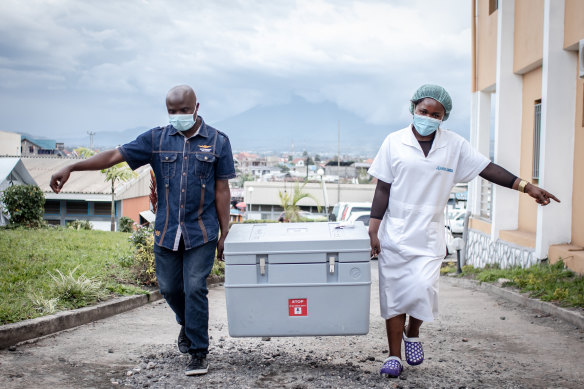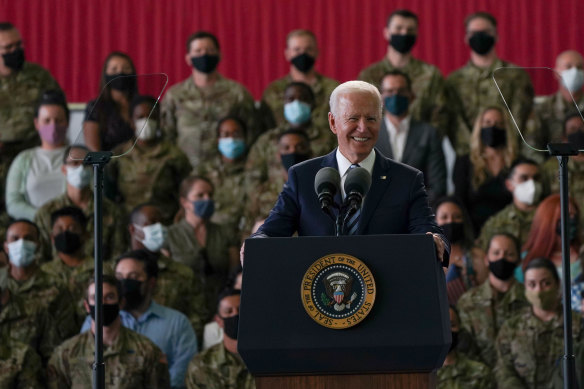This was published 3 years ago
‘COVAX hasn’t failed but it is failing’: global vaccine drive struggles to compete
By Benjamin Mueller and Rebecca Robbins
Deaths from COVID-19 were surging across Africa in June when 100,000 doses of the Pfizer-BioNTech vaccine arrived in Chad. The delivery seemed proof that the United Nations-backed program to immunise the world could get the most desirable vaccines to the least developed nations. Yet five weeks later, Chad’s health minister said, 94,000 doses remained unused.
Nearby in Benin, only 267 shots were being given each day, a pace so slow that 110,000 of the program’s AstraZeneca doses expired. Across Africa, confidential documents from July indicated, the program was monitoring at least nine countries where it said doses intended for the poor were at risk of spoiling this summer.

A shipment of COVAX AstraZeneca arrives in the Democratic Republic of Congo. Many poorer nations struggle to store and ship the doses they receive. Credit: Getty
The vaccine pile-up illustrates one of the most serious but largely unrecognised problems facing the immunisation program as it tries to recover from months of missteps: difficulty getting doses from airport tarmacs into people’s arms.
Known as COVAX, the program was supposed to be a global powerhouse, a multibillion-dollar alliance of international health bodies and non-profits that would ensure through sheer buying power that poor countries received vaccines as quickly as the rich.
Instead, COVAX has struggled to acquire doses: it stands half a billion short of its goal. Poor countries are dangerously unprotected as the Delta variant runs rampant, just the scenario that COVAX was created to prevent.
The urgent need to vaccinate the world goes far beyond protecting people in poor nations. The longer the virus circulates, the more dangerous it can become, even for vaccinated people in wealthy countries.
“COVAX hasn’t failed, but it is failing,” said Dr Ayoade Alakija, a co-chair of the African Union’s vaccine delivery program. “We really have no other options. For the sake of humanity, COVAX must work.”
More supplies are finally on the way, courtesy of the Biden administration, which is buying 500 million Pfizer doses and delivering them through COVAX, the centrepiece of a larger pledge by wealthy democracies. The donated doses should begin shipping this month.
But the Biden donation, worth $US3.5 billion ($4.7 billion), comes with a caveat: To help fund it, the administration is diverting hundreds of millions of dollars promised for vaccination drives in poorer countries, according to notes from a meeting between COVAX and American officials. Short on funding, those countries struggle to buy fuel to transport doses to clinics, train people to administer shots or persuade people to get them.
Even as COVAX officials scramble to fill that funding gap, the overriding question is whether the program can move beyond an imbalance of power that has left it at the mercy of wealthy countries and pharmaceutical companies. Pfizer, for example, balked at a direct deal with COVAX this spring, interviews reveal, instead reaching an agreement through the Biden administration, an arrangement that hurt COVAX’s credibility as an independent vaccine purchaser.
Driven by a nonprofit funded by the Gates Foundation, COVAX is a creation without precedent. It has gotten vaccines to poorer countries faster than was previously typical and developed a system to compensate people for serious post-vaccine reactions and protect vaccine-makers from legal liability — a plan that saved those countries months of negotiations.
Still, the 163 million doses it has delivered — most free to poorer nations, with the rest to countries like Canada that paid their way — are a far cry from plans to have at least 640 million doses available by now.
Dr. Seth Berkley, the chief executive of Gavi, the nonprofit at COVAX’s heart, said insufficient early financing made supply shortages inevitable. When distribution problems of the type in Chad and Benin emerge, COVAX tries to “move those vaccines to other countries, but then to work with those countries to try to improve capacity,” he said.
Supporters and critics agree that the program must improve, rapidly. As of early July, confidential COVAX documents indicated that 22 nations, some with surging fatalities, reported being nearly or entirely out of doses from the program.
“The way COVAX was packaged and branded, African countries thought it was going to be their saviour,” said Dr Catherine Kyobutungi, who directs the African Population and Health Research Center. “When it didn’t meet expectations, there was nothing else.”
Rich and Poor
In the frantic early months of 2020, health experts strategised on how to equitably inoculate the world. COVAX was the answer, bringing together two Gates-funded nonprofits, Gavi and the Coalition for Epidemic Preparedness Innovations, or CEPI; the World Health Organisation; and UNICEF, which would lead delivery efforts. It hoped to be a major global vaccine buyer, for both rich and poor nations, giving it the clout to bully vaccine-makers.
But if rich nations pledged donations, they did not make obliging partners. Britain negotiated for wealthier participants to be given a choice of vaccines to purchase through COVAX, creating delays, said Kate Elder, senior vaccines policy adviser for Doctors Without Borders’ Access Campaign.
Rich nations also became rivals in a vaccine-buying race, paying premiums to secure their own shots while slow-walking financial pledges that COVAX needed to sign deals.
“You can’t be passing the tin cup in the middle of a pandemic,” said Dr Nicole Lurie, the US director at CEPI, referring to the desperate scramble for financing.
Initially, COVAX planned on giant deliveries from the Serum Institute, an Indian manufacturer. But after the virus surged in India in March, the Indian government halted vaccine exports. Many poor countries were rattled. They had banked on COVAX.
Dr Alakija, who is leading African delivery efforts, said health officials in Africa were scarcely consulted in mid-2020 when the program set an initial target of vaccinating at least 20 per cent of poorer countries’ populations. Alakija recalled that people involved in COVAX had said they believed Africa was at low risk and mass immunisation were unnecessary, a claim a Gavi spokesperson denied.
The spokesperson said that the target was set in the face of “limited resources” and “a limited understanding of COVID-19 epidemiology,” and that it now had enough money to buy vaccines for almost 30 per cent of poorer countries’ populations.
Desperate, 17 countries eligible for free COVAX doses, including Rwanda, have struck deals to buy doses from Pfizer directly.
By this May, COVAX appeared poised to strike a new deal of its own to buy low-cost doses from Pfizer. It had already ordered 40 million in January; this deal was expected to be bigger.
But behind the scenes, tension was simmering between Pfizer and COVAX, two people familiar with the negotiations said. The company wanted the new doses to go to poorer nations alone. As a global purchasing pool, COVAX insisted on also fulfilling orders from wealthier countries that had been buying directly at higher prices. South Korea, for example, had received Pfizer doses from the program.
And the two sides had already tangled. In negotiations over the first round of doses, Pfizer had sought liability protections beyond COVAX’s model indemnification agreement, Berkley said, asking countries to sign additional legal letters.

Joe Biden promised 500 million doses for COVAX during the G7, but money was cut from other programs to help finance it. Credit: Getty
Into the standoff stepped Jeffrey Zients, President Joe Biden’s coronavirus response coordinator. To allay Pfizer’s unease about wealthier nations getting the doses, the White House would donate the vaccines to only the program’s poorest countries, as well as the African Union.
The United States is paying about $US7 ($9) per donated dose, roughly a third of Pfizer’s price for Americans, two people familiar with the deal said. Berkley said the U.S. purchase allowed COVAX to get more doses, and faster, than the program was trying to secure on its own.
A Pfizer spokesperson, Sharon Castillo, said the company had “a collaborative relationship” with COVAX.
Jeremy Konyndyk, executive director of USAID’s COVID-19 Task Force, acknowledged that the United States had diverted some distribution funds to pay for Pfizer doses because contributing shots was the priority.
But it also highlighted COVAX’s difficulty securing a major supply agreement by itself, people involved with the program said — a reputational blow, even as it needs to wrestle with other manufacturers.
Production issues have choked deliveries in June from COVAX’s main supplier, AstraZeneca, which said shipments had since picked up. Johnson & Johnson, which also had production struggles, has yet to deliver any doses ordered by COVAX.
Several major vaccine-makers only recently agreed to supply the program, including Moderna and two Chinese companies.
“The world is making a couple hundred million doses a week, so there’s not a supply problem,” said Dr Bruce Aylward, a senior adviser to the World Health Organization. Instead, he said, vaccine-makers and world leaders were electing to put rich countries first: “There’s a choice problem.”
The New York Times
Stay across the most crucial developments related to the pandemic with the Coronavirus Update. Sign up for the weekly newsletter.